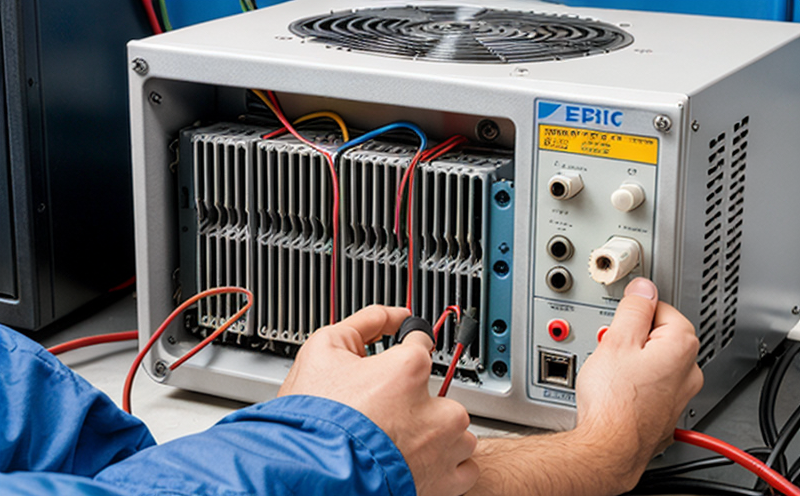IEC 60349 Electrical Traction Motor Testing for Ships
The International Electrotechnical Commission (IEC) Standard IEC 60349 provides comprehensive guidelines for the testing and certification of traction motors used in marine applications. This standard ensures that electrical traction motors meet stringent safety, performance, and reliability requirements necessary for safe operation in ships.
IEC 60349 covers a range of tests including insulation resistance measurement, winding resistance test, no-load speed and current test, load torque and power test, withstand voltage test, and temperature rise test. These tests are critical to ensure the motor can operate under various environmental conditions encountered in marine settings.
The testing procedure outlined by IEC 60349 is designed for electrical traction motors used in ships such as those powering propulsion systems, auxiliary machinery like pumps and compressors, and cranes. The standard takes into account the specific operating environments of these applications, including saltwater exposure, vibration, and extreme temperature variations.
Before testing begins, the motor must be thoroughly inspected to ensure it meets the initial criteria specified in IEC 60349. This includes checking for any visible damage or defects that could affect test results. Once the inspection is complete, the motor undergoes a series of tests:
- Insulation resistance measurement
- Winding resistance test
- No-load speed and current test
- Load torque and power test
- Withstand voltage test
- Temperature rise test
The testing process is carried out using specialized equipment designed to replicate the operational conditions of a marine environment. This includes humidity chambers, salt spray cabinets, and vibration simulators. The data collected during these tests are analyzed to ensure compliance with IEC 60349 standards.
Compliance with this standard ensures that electrical traction motors for ships can operate reliably under harsh marine conditions. It also helps manufacturers meet regulatory requirements and enhances the overall safety of ship operations by ensuring that only high-quality, durable motors are used in critical applications.
| Test | Description | Objective |
|---|---|---|
| Insulation resistance measurement | Determines the insulation quality of motor windings | Avoids electrical faults and ensures safe operation |
| Winding resistance test | Measures the resistance values in the motor windings | Ensures efficient power transfer and optimal performance |
| No-load speed and current test | Determines the no-load performance of the motor | Evaluates the efficiency and operational limits under light load conditions |
| Load torque and power test | Tests the motor's ability to deliver rated torque and power at full load | Ensures it can handle heavy workloads without failure |
| Withstand voltage test | Assesses the motor’s ability to withstand high-voltage surges | Avoids insulation breakdown due to overvoltage conditions |
| Temperature rise test | Measures the temperature increase in the motor windings during operation | Evaluates thermal stability and prevents overheating damage |
Industry Applications
- Propulsion systems for ships
- Auxiliary machinery such as pumps, compressors, cranes
- Motors in safety-critical applications like fire pumps and emergency generators
- Diesel-electric hybrid propulsion systems
The IEC 60349 standard ensures that electrical traction motors used in these critical applications are reliable and safe. By testing the motors according to this standard, manufacturers can ensure compliance with international regulations and improve the overall safety of marine operations.
Why Choose This Test
Selecting IEC 60349 Electrical Traction Motor Testing for Ships is essential for several reasons:
- Ensures Safety: The standard helps identify potential hazards before they can cause accidents or failures.
- Compliance with Regulations: It ensures that all electrical traction motors meet international safety and performance standards.
- Enhances Reliability: By thoroughly testing the motor under various conditions, this process identifies any weaknesses early in the development cycle.
- Cost Savings: Early detection of defects through rigorous testing can prevent costly repairs or replacements later on.
Choosing IEC 60349 Electrical Traction Motor Testing for Ships also enhances a company's reputation by demonstrating commitment to quality and safety. This can be particularly important when bidding on contracts with stringent regulatory requirements.
Environmental and Sustainability Contributions
The testing process outlined in IEC 60349 plays a crucial role in enhancing the environmental footprint of marine operations by ensuring that only reliable, high-quality motors are used. This helps reduce the likelihood of failures leading to pollution or accidents.
By ensuring that electrical traction motors meet stringent safety and performance standards, this testing process contributes significantly to sustainable shipping practices. It helps minimize downtime, which in turn reduces fuel consumption and emissions from idling engines.
The use of IEC 60349 also supports the development of more efficient marine propulsion systems, contributing to overall industry sustainability goals.





